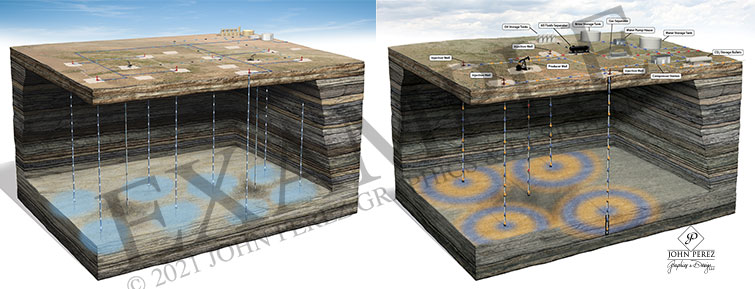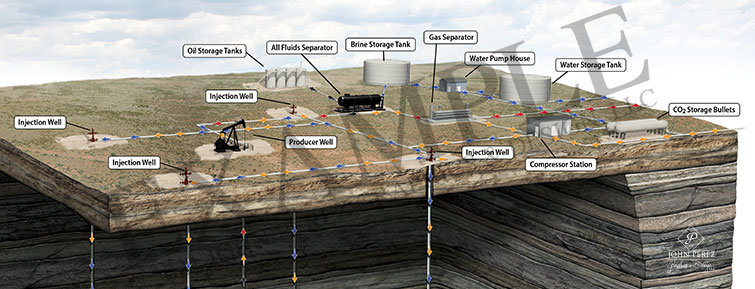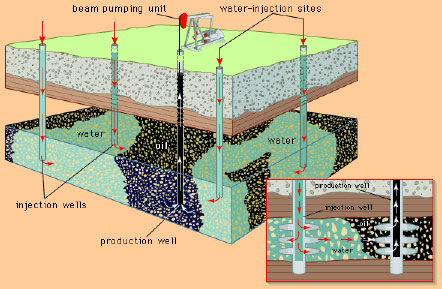Recovery Methods

Water Flooding
PRIMARY RECOVERY: First stage of hydrocarbon production, in which natural reservoir energy, such as gasdrive, waterdrive, or gravity drainage, displaces hydrocarbons from the reservoir, into the wellbore and up to the surface. The primary recovery stage reaches its limit either when the reservoir pressure is so low that the production rates are not economical, or when the proportions of gas or water in the production stream are too high. During primary recovery, only a small percentage of the initial hydrocarbons in place are produced, typically around 10% for oil reservoirs. (Schlumberger)
SECONDARY RECOVERY: Second stage of hydrocarbon production during which an external fluid such as water or gas is injected into the reservoir through injection wells located in rock that has fluid communication with production wells. The purpose of secondary recovery is to maintain reservoir pressure and to displace hydrocarbons toward the wellbore. The most common secondary recovery techniques are gas injection and waterflooding. Normally, gas is injected into the gas cap and water is injected into the production zone to sweep oil from the reservoir. A pressure-maintenance program can begin during the primary recovery stage, but it is a form or enhanced recovery. The secondary recovery stage reaches its limit when the injected fluid (water or gas) is produced in considerable amounts from the production wells and the production is no longer economical. The successive use of primary recovery and secondary recovery in an oil reservoir produces about 15% to 40% of the original oil in place. (Schlumberger)

Water Injection:
When an oil reservoir is first produced, the pressure that exists in the subsurface provides the energy for moving the oil, gas and water that is in the rock to the surface. After a while, the pressure dissipates and pumps must be used to remove additional volumes of oil. Depending on the characteristics of the rock and the oil, a considerable amount of the original oil in place may be left behind (perhaps 60 percent or more) as residual oil. Waterflooding is a process whereby water is pumped down selected wells to push a portion of the remaining oil out of the rock towards the producing wells. In most cases, CO2 enhanced recovery operations take place in oil reservoirs where this less expensive waterflooding option has already been implemented, although the remaining oil saturation in the post-waterflood reservoir is still significant, perhaps 50 percent of the original oil in place. (DOE “CO2 Enhanced”)
The injected water is often oilfield brine from the separators but can also be water from other sources that has been treated. The injected water must be compatible with the producing formations and not cause reactions that decrease the permeability of the formation being flooded. Suspended solids that can plug the pores are removed from the injection water by filtration. Organic matter and bacteria that produce slimes are neutralized by biocides. Oxygen is removed from the water to prevent corrosion. (Hyne “Nontechnical Petro”)
While production wells can be converted into injection wells, water-injection wells are also drilled specifically for this purpose. Water is then pumped into the reservoir, or gravity can help to push the liquid into the formation. This solution positions water tanks on hills or somewhere above the well, and the water simply is fed into the wellbore. (Rigzone “Water Injection”)
Waterfloods are described by the aerial pattern of the wells and are either spot or line drives. The common five-spot pattern has four water-injecting wells located at the corners of a square with a producing well at the center. The pattern is repeated in the field so that four injection wells surround each producing well and four producing wells surround each injection well. A seven-spot pattern has six injector wells surrounding a producer; whereas an inverted seven-spot pattern has six producer wells surrounding an injector. A line drive has alternating lines of producers and injectors and can be either direct or staggered. An edge waterflood uses injection wells along the margin of the field. The injected water drives oil up and toward the producing wells in the center. (Hyne “Nontechnical Petro”)
Primary production usually only recovers some 30 to 35% of the oil in place. Although the effectiveness of water injection varies according to the formation characteristics, a waterflood can recover anywhere from 5% to 50% of the oil that is remaining in the reservoir, greatly enhancing the productivity and economics of the development. (Rigzone “Water Injection”)
This form of EOR is typically more productive when there are relatively small amounts of primary production, and the process becomes uneconomical when the water cut reaches the 90 to 99% level. Some waterfloods may take up to two years of injection before production is increased; and some reservoirs do not have the right characteristics, and water injection is not a viable option for increasing production from waning wells. (For example, water injection is never used on natural gas wells.) (Rigzone “Water Injection”)
Fluids such as water will always flow along the route of least resistance. A reservoir rock might have a zone of high permeability, such as a well-sorted bed of sandstone or a porous or fractured zone in limestone. As the water sweeps through the reservoir, the injected water flows fastest through the most permeable zone (a thief zone) and reaches the producing well to cause a breakthrough. Once a breakthrough occurs, the rest of the water will tend to flow through that permeable zone bypassing oil in the less permeable portions of the reservoir. The sooner the water breaks through, the less efficient the waterflood. (Hyne “Nontechnical Petro”)
TERTIARY RECOVERY (EOR): uses sophisticated techniques that alter the original properties of oil. Once ranked as a third stage of oil recovery that was carried out after secondary recovery, the techniques employed during enhanced oil recovery can actually be initiated at any time during the productive life of an oil reservoir. Its purpose is not only to restore formation pressure, but also to improve oil displacement or fluid flow in the reservoir. With much of the easy-to-produce oil already recovered from U.S. oil fields, producers have attempted several tertiary, or enhanced oil recovery (EOR), techniques that offer prospects for ultimately producing 30 to 60 percent, or more, of the reservoir’s original oil in place. (DOE “EOR/CO2”) Three major types of EOR are chemical flooding (alkaline or micellar-polymer flooding), miscible displacement (CO2 injection or hydrocarbon injection), and thermal recovery (steamflood or in situ combustion). (Schlumberger)
Used in fields that exhibit heavy oil, poor permeability and irregular faultlines, EOR entails changing the actual properties of the hydrocarbons, which further distinguishes this phase of recovery from the secondary recovery method. While waterflooding and gas injection during the secondary recovery method are used to push the oil through the well, EOR applies steam or gas to change the makeup of the reservoir. (Rigzone “EOR”)
Chemical Injection:
Chemical injection, which can involve the use of long-chained molecules called polymers to increase the effectiveness of waterfloods, or the use of detergent-like surfactants to help lower the surface tension that often prevents oil droplets from moving through a reservoir. Chemical techniques account for about one percent of U.S. EOR production. (DOE “EOR/CO2”)
A chemical flood injects different fluids into the depleted reservoir in separate batches (slugs). The fluids, each serving a different purpose, move as a separate fronts from the injection wells, through the reservoir rock toward the producing wells. In a micellar-polymer flood, a slug of reservoir water is first injected to condition the reservoir as it moves ahead of other slugs of injected chemicals. Next, a slug of surfactant solution is injected into the reservoir. The surfactant acts as a detergent, reducing the surface tension of the oil and washing the oil out of the reservoir pore spaces. The oil forms small droplets suspended in the water called a microemulsion. The next slug is water thickened by polymers. Pressure on the polymer water from the injection well drives the surfactant and oil microemulsion front ahead through the reservoir toward producing wells. A chemical flood can only be used for sandstone reservoirs because carbonates absorb the surfactants. It can recover about 40% of the remaining oil but is an expensive process. (Hyne “Nontechnical Petro”)

Gas Injection:
Gas injection used as a tertiary method of recovery involves injecting natural gas, nitrogen or carbon dioxide into the reservoir. The gases can either expand and push gases through the reservoir, or mix with or dissolve within the oil, decreasing viscosity and increasing flow. (Rigzone “EOR”) Gas injection accounts for nearly 60 percent of EOR production in the United States. (DOE “EOR/CO2”)
CO2:
The EOR technique that is attracting the most new market interest is carbon dioxide (CO2)-EOR. First tried in 1972 in Scurry County, Texas, CO2 injection has been used successfully throughout the Permian Basin of West Texas and eastern New Mexico, and is now being pursued to a limited extent in Kansas, Mississippi, Wyoming, Oklahoma, Colorado, Utah, Montana, Alaska, and Pennsylvania. (DOE “EOR/CO2”)
Until recently, most of the CO2 used for EOR has come from naturally-occurring reservoirs. But new technologies are being developed to produce CO2 from industrial applications such as natural gas processing, fertilizer, ethanol, and hydrogen plants in locations where naturally occurring reservoirs are not available. One demonstration at the Dakota Gasification Company’s plant in Beulah, North Dakota is producing CO2 and delivering it by a new 204-mile pipeline to the Weyburn oil field in Saskatchewan, Canada. Encana, the field’s operator, is injecting the CO2 to extend the field’s productive life, hoping to add another 25 years and as much as 130 million barrels of oil that might otherwise have been abandoned. (DOE “EOR/CO2”)
Why use CO2?
- it is miscible with crude oil
- less expensive than other similarly miscible fluids
Water and oil don’t mix, but a solvent can mix with oil, form a homogenous mixture, and carry the oil. Natural gas is very miscible with oil but it is relatively expensive. Underground deposits of CO2 are relatively inexpensive, naturally occurring sources of gas. If CO2 produced by human activities can be captured inexpensively, it could become a source as well. (DOE “CO2 Enhanced”)
Under pressure, oil and CO2 have miscibility, (most common when CO2 is compressed and oil is low-density) thus the pressure of a depleted reservoir must be considered when evaluating a well for CO2 injection. Low pressure reservoirs may need to be re-pressurized by injecting water. (DOE “CO2 Enhanced”)
Once the oil and CO2 are miscible, the CO2 can displace the oil from the rock pores. As CO2 dissolves in the oil it swells the oil and reduces its viscosity. Often, CO2 floods involve the injection of volumes of CO2 alternated with volumes of water; water alternating gas or WAG floods. This approach helps to mitigate the tendency for the lower viscosity CO2 to finger its way ahead of the displaced oil. Once the injected CO2 breaks through to the producing well, any gas injected afterwards will follow that path, reducing the overall efficiency of the injected fluids to sweep the oil from the reservoir rock. (DOE “CO2 Enhanced”)
The physical elements of a typical CO2 flood operation can be used to illustrate how the process works. First, a pipeline delivers the CO2 to the field at a pressure and density high enough for the project needs (>1200 pounds per square inch [psi] and 5 pounds per gallon; for comparison water density is 8.3 pounds per gallon), and a meter measures the volume of gas purchased. This CO2 is directed to injection wells strategically placed within the pattern of wells to optimize the areal sweep of the reservoir. The injected CO2 enters the reservoir and moves through the pore spaces of the rock, encountering residual droplets of crude oil, becoming miscible with the oil, and forming a concentrated oil bank that is swept towards the producing wells. (DOE “CO2 Enhanced”)
The produced fluids are separated and the produced gas stream, which may include amounts of CO2 as the injected gas begins to break through at producing well locations, must be further processed. Any produced CO2 is separated from the produced natural gas and recompressed for reinjection along with additional volumes of newly-purchased CO2. In some situations, separated produced water is treated and re-injected, often alternating with CO2 injection, to improve sweep efficiency (the WAG process mentioned earlier). (DOE “CO2 Enhanced”)
Nitrogen: Nitrogen may be used in areas where CO2 is not economically available for use. (DOE NETL “EOR-Gas Flood”). Can be used to recover “light oils” that are capable of absorbing gas under reservoir conditions, are low in methane, and at least 5,000 feet deep to withstand the high injection pressure necessary for the oil to mix with the nitrogen without fracturing the producing formation. When nitrogen is injected into a reservoir, it forms a miscible front by vaporizing lighter oil components. As the front moves away from the injection wells its leading edge goes into solution, or becomes miscible, with the reservoir oil. Continued injection moves the bank of displaced oil toward production wells. Water slugs are injected alternately with the nitrogen to increase the sweep efficiency and oil recovery. Nitrogen can be manufactured on site at relatively low cost by extraction from air by cryogenic separation, and being totally inert it is noncorrosive. (DOE NETL “Miscible Recovery”)
Natural gas: Natural gas is miscible with oil and can be used to clean oil from underground reservoirs, but it is a valuable commodity. It is cheaper to use other gases, especially CO2. (DOE NETL “CO2/EOR”)
Thermal Injection:
Thermal recovery introduces heat to the reservoir to reduce the viscosity of the oil. Many times, steam is applied to the reservoir, thinning the oil and enhancing its ability to flow. First applied in Venezuela in the 1960s, thermal recovery now accounts for more than 50% of applied EOR in the US. (Rigzone “EOR”)Thermal techniques account for over 40 percent of U.S. EOR production, primarily in California. (DOE “EOR/CO2”)
A fireflood (in situ combustion) involves setting the subsurface oil on fire. If the well is shallow, the fire can be started with either a phosphorous bomb or a gas burner lowered down the well. Pumping air into the reservoir to start the fire by spontaneous combustion works in deeper reservoirs. Once the oil is burning, large volumes of air must be injected into the reservoir to sustain the fire. Air pumping is a large expense in a fireflood and increases with depth of the producing formation as more and bigger compressors are required. The fire generates heat, causing the oil to become more fluid. The large volume of hot gasses generated by the fire drives the heated oil toward producing wells. A fireflood will fail if there is not enough oil in place to sustain the fire. The recovery from a fireflood can be 30 to 40% of the oil in place. (Hyne “Nontechnical Petro”)
- Schlumberger Oilfield Glossary (http://www.glossary.oilfield.slb.com/Display.cfm?Term=enhanced%20oil%20recovery)
- Rigzone “What is EOR, and How Does it Work?” (http://www.rigzone.com/training/insight.asp?insight_id=313&c_id=4)
- Rigzone “How Does Water Injection Work?” (http://www.rigzone.com/training/insight.asp?insight_id=341&c_id=4)
- DOE “Enhanced Oil Recovery/CO2 Injection” (http://fossil.energy.gov/programs/oilgas/eor/)
- DOE NETL “Carbon Dioxide Enhanced Oil Recovery: untapped domestic energy supply and long term carbon storage solution” (http://www.netl.doe.gov/technologies/oil-gas/publications/EP/CO2_EOR_Primer.pdf)
- Hyne, Norman “Nontechnical guide to petroleum geology, exploration, drilling, and production”
- DOE NETL “Enhanced Oil Recovery – Gas Flooding” (http://www.netl.doe.gov/technologies/oil-gas/EP_Technologies/ImprovedRecovery/EnhancedOilRecovery/GasFlood.html)
- DOE NETL “Miscible Recovery” (http://www.netl.doe.gov/technologies/oil-gas/publications/eordrawings/BW/bwmr.pdf)
Video:
Denbury four-step process for CO2 capture and EOR (video): (http://www.denbury.com/)
Images:
To enhance oil recovery, carbon dioxide (CO2) is pumped underground, where it mixes with oil, lowering the oil’s viscosity and thereby improving the extraction by production wells. About 10 percent of the carbon dioxide comes out with the extracted oil. A good deal of water from previous waterflooding is also extracted with the oil.
- Lawrence Livermore National Laboratory Science & Technology Review “Probing the Subsurface with Electromagnetic Fields” (https://www.llnl.gov/str/November01/Kirkendall.html)
- DOE NETL “Carbon Dioxide Enhanced Oil Recovery: untapped domestic energy supply and long term carbon storage solution” (http://www.netl.doe.gov/technologies/oil-gas/publications/EP/CO2_EOR_Primer.pdf)
- Rigzone “How Does Water Injection Work?” (http://www.rigzone.com/training/insight.asp?insight_id=341&c_id=4)

- Encyclopedia Britannica Online “waterflooding” (http://www.britannica.com/bps/media-view/113920/0/0/0)
- Schlumberger Excellence in Educational Development “The Weyburn Oil Field – Enhanced Oil Recovery” (https://www.planetseed.com/node/15251)
